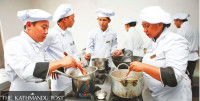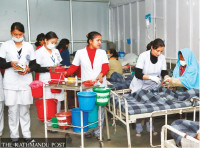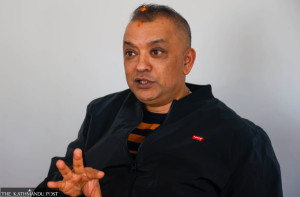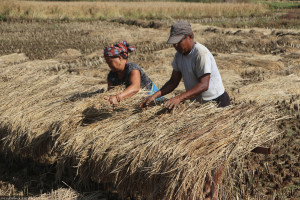Miscellaneous
Heritage Reconstruction 2.0
There is a nifty little galli that cuts through the heart of Thamel and connects Jyatha’s Chinatown to familiar haunts clustered around Chaksibari.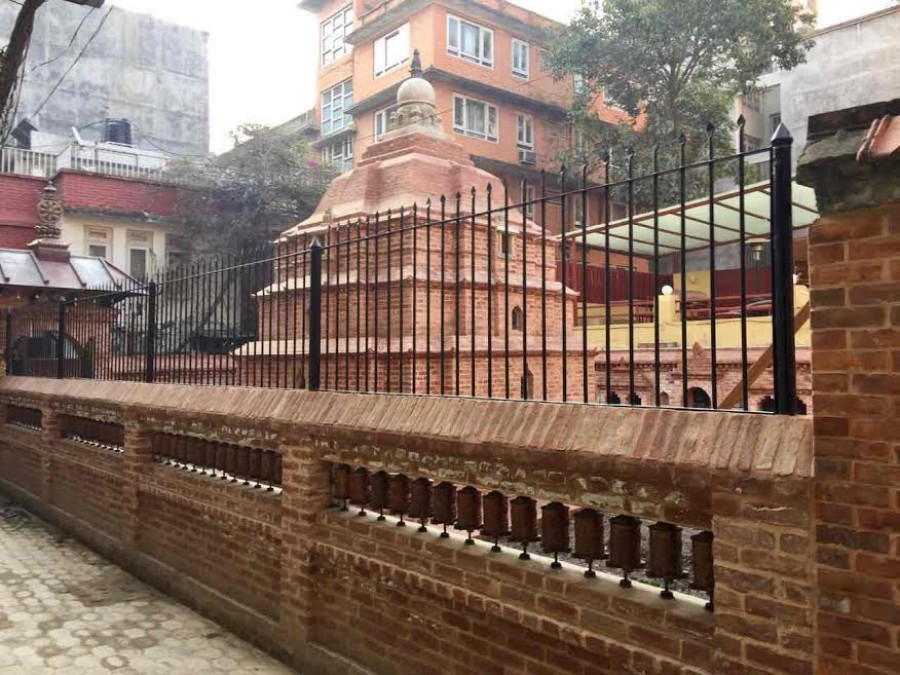
Sanjit Bhakta Pradhananga
"You can keep an old tradition going only by renewing it in terms of current circumstances.”
—Joseph Campbell,
The Power of Myth
***
“Thamel is not the place to stand and stare. Visitors and locals alike are encouraged by the sheer flow of traffic and cheery chat to move along...A thousand stupas and temples await you elsewhere in the city. What’s required here is the wherewithal to organize to see them, so if you have to stop, stop for a good reason...Still, if you look, you will begin to see things.”
—Rabi Thapa,
Thamel: Dark Star of Kathmandu
***
There is a nifty little galli that cuts through the heart of Thamel and connects Jyatha’s Chinatown to familiar haunts clustered around Chaksibari. A few feet across and barely enough for two bikes to pass abreast, Ashok Galli can be a useful shortcut, particularly if you’re looking to avoid the snarling traffic further down the road, where the three lanes from Jyatha, Durbarmarg and Amrit Campus crash into Thamel proper. But for as long as I can remember, no one willingly used the alleyway. Ill-lit, trashed and infested with the “Tyabe” types, Ashok Galli was one of “those” paths you never took, never without company anyhow. Over the years, the galli had seen several stabbings and shootings. And once, murder.
But today, Ashok Galli is a street reborn. On either entrance, bold red and gold signboards welcome visitors into the alley lined by shops selling tea, beads, sculptures and prayer flags. The galli is also home to the sequestered Cha Cha Cafe, two non-descript but bustling Chinese watering holes, several hotels and an obligatory massage parlour. The jewel on this repolished crown, however, is the galli’s namesake, the Lichchhavi-era Ashok Chaitya that has recently been rebuilt through a local initiative. Soaked blood-red by a night’s worth of rain and jutting out proud into a spring blue sky, the Chaitya has now been splendidly salvaged from the very brink. But more than just giving the locale a much-needed facelift, the project has become the glue that has brought a mosaic of people and businesses in the neighbourhood together; underlining that with concerted efforts and perseverance, the Valley’s countless languishing heritages can not only be saved, but be built back better.

Call to adventure
When I visited the Chaitya this week to meet a local contact I’d been referred to, I was fully expecting to write about a Herculean personal journey of a firebrand conservation enthusiast—an impassioned resident, perhaps—out to save a relic imbued with childhood memories. But when I peeled off of Jyatha to arrive at the complex, I was surprised to find a motley crew of middle-aged men marvelling at their labour of love. Ashok Chaitya is not a one-man story; from the very outset it was apparent that this is a story of the entire community.
“This project has been several years in the making,” says Sanjeeb Shrestha, a soft-spoken aeronautical engineer dressed in a smart, blue blazer. “When we started out, we just wanted to clean up the Chaitya and its surroundings which had become dilapidated beyond recognition.” In fact, he tells me, the community did not even realise that the Chaitya was of any significant historical importance, it just was “something that was there,” but needed to be dealt with so that it stopped attracting the wrong crowd. Ashok Chaitya’s fate, I learned, was sealed when the guthi—a traditional Newari social collective—that maintained the complex was deemed defunct in 1976, when the Guthi Corporation Act co-opted all its functions and proceedings. Then the Chaitya, like many other heritages maintained by guthis, fell into gradual disrepair, with institutional neglect, rodents and the elements extracting a heavy toll. When the Sanchaya Kosh building was built right around the corner, the authorities decided that the Chaitya’s premises would make for the perfect dumping ground and buried parts of the complex under several feet of excavated dirt. “At any given day, you’d find stoners and louts ambling about. The Chaitya had become an open toilet and perennially reeked of urine. Something had to give.”
We are seated in a nearby travel agency that has doubled up as the “office” for the initiative. I am flanked by members of a local committee created to manage the project, many of whom come and go through the length of our conversation. The septuagenarian Urgen Chiring, the proprietor of the nearby Hotel Utse, is dozing off in the morning sun—he has nothing to add but nevertheless makes it a point to remain in attendance. And to my right, Surya Joshi is listening in, impatiently. Joshi is a local resident and his face is dominated by tired, puffy eyes. They, however, light up with evangelical fervour, as he forcefully butts into the conversation. “That’s not how it really started though,” he begins, recounting his own version of how the project took off. “Three years ago, a travelling Chinese monk who went by the name of Yan Han Seng got a few locals together and pleaded us to restore the premises. He told us that relics from a very important religious leader were buried at the Chaitya which was chronicled in historical Chinese texts. At first, we didn’t make much of it, but when he returned the next day with Rs 300,000 in cash as seed money, we were all shocked.” The mysterious monk, Joshi reiterates, was insistent that repairs begin immediately. “Then, poof, he disappeared. We have not seen him since. He left a phone number and an email address, but we have not been able to contact him. I, for one, took it as a sign.” Some of the members nod in agreement, others break out into scoffs. “Icchya garnu parcha, Sansar le puryaidincha (If you will it, the universe will provide),” he declares. He repeats the phrase several times throughout the conversation.

Road of trials
Whether initiated by cosmic will or just plain frustration within the local community, any overhaul of heritage sites is overseen by a tangle of bureaucratic red tape. “We found out the hard way,” admits Shrestha, who is also the president of the committee, “Suddenly we had Rs 300,000 in our hands and absolutely no idea about where to actually begin.”
It is a subject that keenly interests Govinda Prasad Pantha, who owns a bead shop a few doors down. You can tell he did a significant portion of the ‘official running around’ on behalf of the community. “It was all very frustrating,” he says, “We were running from pillar to post—from the ward office to the metropolitan office to the heritage bureau to the Department of Archaeology and then round and round. We had no reference point.” Committee members, according to Pantha, spent weeks and months being ordered from desk to desk, partly because they themselves were learning through trial and error. Then when finally the Kathmandu Metropolitan City agreed to go in on an 80:20 ratio partnership with the locals, the 2015 earthquake halted the plans once more.
Those months, Pantha says, were the hardest for the project. The Chaitya suffered further damages during the quakes and their petition stalled at the KMC. “But the one thing we learned is that you can’t give up,” he says, “Eventually things click into gear.” Shrestha too is keen to reiterate that the system begrudgingly works, but only when locals take the initiative. To date, the committee has received Rs 880,000 from the KMC, free technical expertise from the DOA and the ward office even installed a solar street lamp; a bonus.
And then as the project began to gain footing, others began to chip in. Restorers Rohit Ranjitkar and Rabi Jonchhay helped create a blueprint that would not only restore the Chaitya in the traditional Lichchhavi style it was built in, but would create a complimenting space around it. Young architect Alina Tamrakar volunteered the designs for an intricate sattal to run along the eastern wall. Pasa Maharjan and his Dakshin Barahi brick factory helped churn out customised traditional bricks—dacchi appa and ma appa—at cost. Masons came in from Bhaktapur, the stone workers from Sankhamul, the carpenters from Bungamati.
The money too started flowing in; first from locals, then from nearby hotels and restaurants, and eventually even as far away as China and Switzerland. The committee has so far raised Rs 2,500,000 on its own, and with KMC’s input, the project looks set to be completed for under three and a half million. Had it gone through the usual lowest-bidder tender process, the committee members point out, the costs would have run north of six million.

A newly-designed sattal will now run along the eastern boundary of the Chaitya complex.
Return with Elixir
Ashok Chaitya’s restoration has been a roaring success, but there is a deeper undercurrent that makes the project more the fascinating. Ashok Chaitya was not rebuilt with religious fervour (except perhaps that of the evangelical-eyed Surya Joshi). The committee and the DOA don’t know who the Chaitya was built for or when; they still interchangeably call it a stupa, a chaitya and a vihar. And the complex makes more for a contemplative space than it does for religious activity.
The project isn’t ethnically driven either. The group is a ragtag mix of locals born in the neighbourhood, longstanding migrants who have come to call Jyatha home, nearby business owners and travelling monks and tourists.
But starting out from just dealing with “something that was just there,” Ashok Chaitya has evolved into a community space, created through local financial and emotional investment. “We feel such a strong sense of ownership,” says Shrestha, “I guarantee that this complex will be well taken care of for a generation, hopefully more. Had we waited for others to take the initiative, the Chaitya perhaps would have never been rebuilt. At some point, it is the communities that need to step up.”
What’s more, the committee, with the help of Save Heritage—a collective of heritage conservation enthusiasts—is currently creating a manual as a reference point for other communities that may want to replicate what has been done at Ashok Chaitya. It will come complete with a checklist for all the processes and a mapped-out guide to the concerned government departments and their contacts. Should another community decide to brave the behemoth bureaucracy, they will now at least have a benchmark. “For us it was like going to school, learning from scratch,” ribs Pantha, “the manual will be a cheat sheet.”
All things even, Ashok Chaitya will be consecrated with a Tibetan Buddhist ceremony next month. But with some more luck, it will remain a treasured community asset for generations. That is, after all, why public spaces and heritages are built in the first place; as physical and mental spaces that brings people together and binds them. And though Ashok Chaitya’s renovation may not be tinged with religious overtones as it was when first built 1300 years ago, it is thoroughly imbued with community ownership that kept it alive for the millennia after.





 13.12°C Kathmandu
13.12°C Kathmandu



